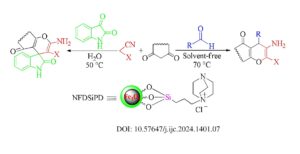As a natural-based catalyst, nano-Fe3O4@dextrin/Si(CH2)3/DABCO was fabricated and characterized with different analytical methods such as field emission scanning electron microscopy, X-ray diffraction, Fourier-transform infrared spectroscopy, X-ray mapping, energy-dispersive X-ray spectroscopy, thermogravimetric analysis, and vibrating sample magnetometer. The mentioned new natural magnetic nanocatalyst was employed for the three-component synthesis of tetrahydrobenzo[b]pyrans and spirooxindoles from aromatic aldehyde […]
As a natural-based catalyst, nano-Fe3O4@dextrin/Si(CH2)3/DABCO was fabricated and characterized with different analytical methods such as field emission scanning electron microscopy, X-ray diffraction, Fourier-transform infrared spectroscopy, X-ray mapping, energy-dispersive X-ray spectroscopy, thermogravimetric analysis, and vibrating sample magnetometer. The mentioned new natural magnetic nanocatalyst was employed for the three-component synthesis of tetrahydrobenzo[b]pyrans and spirooxindoles from aromatic aldehyde […]

An efficient synthesis of 2,4,5-trisubstituted and 1,2,4,5-tetrasubstituted imidazoles by one-step condensation of an aldehyde, benzil, ammonium acetate and primary amine in the presence of nanocrystalline magnesium aluminate under microwave irradiation is described. The advantages of this catalyst are including simple work-up, low cost and reusability. Compared with conventional methods, the main advantages of the present […]
Melamine trisulfonic acid (MTSA) as an efficient heterogeneous catalyst has been used for the one-pot preparation of triazolo[1,2-a]indazole-1,3,8-trione and 2H-indazolo[2,1-b]phthalazine-1,6,11-trione derivatives by the three-component condensation reaction of urazoles or phthalhydrazide, dimedone or 1,3-cyclohexanedione, and aldehydes under solvent-free conditions in good to excellent yields and short reaction times.
Facile and versatile procedures have been explored for the synthesis of tetrahydropyridines and 2,3-dihydroquinazolin-4(1H)-ones. These protocols employ the one-pot multi-component condensation of arylaldehydes and aromatic amines with β-keto esters and isatoic anhydride in chloroacetic acid, respectively. The reactions proceeded smoothly to generate the corresponding products in high yield. We have found that the use of […]
Herein we explore facile synthesis of 4-(3H)-Qunazolinone derivatives, achieved by the cyclocondensation of anthranilic acid, aromatic amines and triethyl orthoformate in presence of thiamine hydrochloride (Vitamin B1) as a catalyst, using grinding method. This protocol offers several advantages such as reusability of catalyst, excellent yield, shorter reaction time and economic availability.Quinazolinone derivatives are one of […]
A Simple and efficient method for synthesis of tetrahydropyrimido[4,5-b]quinoline derivatives via three component reaction of aromatic aldehydes, dimedone and 6-amino uracil derivatives using a catalytic amount of sulfonic acid functionalized nanoporous silica (SBA-15-Pr-SO3H) is described. The advantages of this method are easy and clean work-up, high yield, mild reaction condition, reusable catalyst and environmentally benign […]
A highly practical and efficient preparation of 3,4-Dihydropyrimidin-2(1H)-one derivatives was developed via an efficient and simple nanocatalyst and promoted multi-component reaction of ethyl acetoacetate, aromatic aldehyde, and urea in the presence of a catalytic amount of (CTA)3[SiW12]-Li+-MMT under solvent-free conditions. In comparison to the conventional methods, the salient features of this method are green reaction […]
Fe (III) supported graphitic carbon nitride nanocomposite was synthesized by impregnation of FeCl3 with g- C3N4 (Fe (III)@g-C3N4). Then, the synthesis of spirooxindole derivatives was carried out in the presence of Fe (III) @ graphitic carbon nitride nanocompositevia the multi-component reaction of malononitrile, isatins, and 1,3-dicarbonyl compounds in green media (ethanol/water (1:1)) under reflux conditions […]
One of the important Multi-component reaction (MCRs) is the synthesis of dihydropyrano chromene derivatives by one-pot reaction. In this research, an inexpensive and effective one pot three component procedure with good yields for the synthesis of dihydro pyrano chromenes is reported. In this method, the synthesis of pyrano chromene derivatives was followed by using 4-hydroxycoumarin, […]